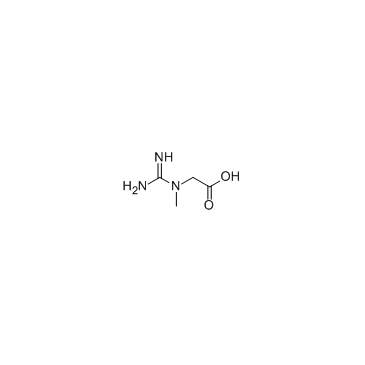Creatine

Creatine structure
|
Common Name | Creatine | ||
|---|---|---|---|---|
| CAS Number | 57-00-1 | Molecular Weight | 131.133 | |
| Density | 1.4±0.1 g/cm3 | Boiling Point | 271.6±42.0 °C at 760 mmHg | |
| Molecular Formula | C4H9N3O2 | Melting Point | ~295 °C (dec.) | |
| MSDS | Chinese USA | Flash Point | 118.1±27.9 °C | |
|
Suramin inhibits Hsp104 ATPase and disaggregase activity.
PLoS ONE 9(10) , e110115, (2014) Hsp104 is a hexameric AAA+ protein that utilizes energy from ATP hydrolysis to dissolve disordered protein aggregates as well as amyloid fibers. Interestingly, Hsp104 orthologues are found in all kingdoms of life except animals. Thus, Hsp104 could represent a... |
|
|
BRF1 mutations alter RNA polymerase III-dependent transcription and cause neurodevelopmental anomalies.
Genome Res. 25(2) , 155-66, (2015) RNA polymerase III (Pol III) synthesizes tRNAs and other small noncoding RNAs to regulate protein synthesis. Dysregulation of Pol III transcription has been linked to cancer, and germline mutations in genes encoding Pol III subunits or tRNA processing factors... |
|
|
Propofol increases morbidity and mortality in a rat model of sepsis.
Crit. Care 19 , 45, (2015) Severe sepsis is associated with approximately 50% mortality and accounts for tremendous healthcare costs. Most patients require ventilatory support and propofol is commonly used to sedate mechanically ventilated patients. Volatile anesthetics have been shown... |
|
|
Cheminformatics analysis of assertions mined from literature that describe drug-induced liver injury in different species.
Chem. Res. Toxicol. 23 , 171-83, (2010) Drug-induced liver injury is one of the main causes of drug attrition. The ability to predict the liver effects of drug candidates from their chemical structures is critical to help guide experimental drug discovery projects toward safer medicines. In this st... |
|
|
HMDB: a knowledgebase for the human metabolome.
Nucleic Acids Res. 37(Database issue) , D603-10, (2009) The Human Metabolome Database (HMDB, http://www.hmdb.ca) is a richly annotated resource that is designed to address the broad needs of biochemists, clinical chemists, physicians, medical geneticists, nutritionists and members of the metabolomics community. Si... |
|
|
The human serum metabolome.
PLoS ONE 6(2) , e16957, (2011) Continuing improvements in analytical technology along with an increased interest in performing comprehensive, quantitative metabolic profiling, is leading to increased interest pressures within the metabolomics community to develop centralized metabolite ref... |
|
|
Prediction of skeletal muscle and fat mass in patients with advanced cancer using a metabolomic approach.
J. Nutr. 142(1) , 14-21, (2012) Urine and plasma metabolites originate from endogenous metabolic pathways in different organs and exogenous sources (diet). Urine and plasma were obtained from advanced cancer patients and investigated to determine if variations in lean and fat mass, dietary ... |
|
|
HAX-1 regulates cyclophilin-D levels and mitochondria permeability transition pore in the heart.
Proc. Natl. Acad. Sci. U. S. A. 112 , E6466-75, (2015) The major underpinning of massive cell death associated with myocardial infarction involves opening of the mitochondrial permeability transition pore (mPTP), resulting in disruption of mitochondria membrane integrity and programmed necrosis. Studies in human ... |
|
|
¹H-NMR and MS based metabolomics study of the intervention effect of curcumin on hyperlipidemia mice induced by high-fat diet.
PLoS ONE 10(3) , e0120950, (2015) Curcumin, a principle bioactive component of Curcuma longa L, is well known for its anti-hyperlipidemia effect. However, no holistic metabolic information of curcumin on hyperlipidemia models has been revealed, which may provide us an insight into the underly... |
|
|
Use of high-resolution proton nuclear magnetic resonance spectroscopy for rapid multi-component analysis of urine.
Clin. Chem. 30(3) , 426-32, (1984) Numerous low-Mr metabolites--including creatinine, citrate, hippurate, glucose, ketone bodies, and various amino acids--have been identified in 400- and 500-MHz proton nuclear magnetic resonance (1H NMR) spectra of intact human urine. The presence of many of ... |